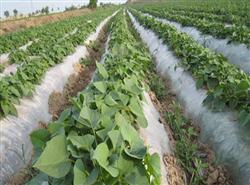Technical advice on field management of sweet potato in middle stage

From the number of tuber basically stable to the peak of stem and leaf growth is the middle growth stage (vine potato and long-term), spring potato is about 60-100 days after planting, and summer potato is about 40-70 days after planting. The accumulation of nutrients and the growth of stems and leaves went hand in hand, and the leaf area coefficient reached a peak of 4.0-4.5 at the end of this period. the main goal of this period was the balanced growth of aboveground and underground parts, and the core of management was to promote the stable growth of stems and leaves and the expansion of potato tubers. The main measures are as follows: first, drought prevention and drainage when the leaves wither at noon, the sunset can not be restored, such as 5-7 consecutive days, conditional watering can promote the rapid recovery of sweet potato growth, irrigation water ridging cultivation is suitable for semi-ditch water. In the rainy season, the "three ditches" of monopolized ditch, waist ditch and drainage ditch are connected to ensure that there is no stagnant water in the field. Special attention should be paid to the timely elimination of stagnant water in depressed and waterlogged land in order to minimize the impact of excessive soil moisture on sweet potatoes. Second, topping and raising seedlings without turning seedlings, chemical regulation, combination of promotion and control, for potato fields with sufficient bottom fertilizer and a trend of prosperous growth after rain, do not cut seedlings. On the basis of topping during the closure period, when the branch length reaches about 1 foot, top one or two times, and the maximum leaf area coefficient should not exceed 5.0. After rain, pick up the potato seedlings in the silt soil and put them back to the original place, do not disturb the rational layout of leaves, do not damage stems and leaves, break the fine roots on the vine, cut off the fiber roots in the surface soil of sweet potato halter, and reduce the absorption of water by the plant. When there is still a growing trend, use 15% paclobutrazol 75 grams per mu with 50 kg of water, foliar spray, there is still a prosperous growth trend after 10 days, can be sprayed again. If the growth is caused by too much nitrogen fertilizer, the solution of 300 times potassium dihydrogen phosphate can be sprayed twice. However, if the stem and leaf growth is insufficient and the leaf area coefficient is less than 3.5, the mixture of 1% urea and 0.2% potassium dihydrogen phosphate can be sprayed for 2 times and promoted appropriately. Third, the prevention and control of diseases, pests and weeds will encounter the harm of bridge insects, sweet potato Tian'e, sweet potato wheat moth, red spiders and other pests in the middle stage of sweet potato growth. In case of occurrence, 50% phoxim 1500 liquid can be used for foliar spraying. If purple feather disease is found (purple hyphae appear in the lower soil layer of the plant, encircling potato lumps, causing potato block rot in the later stage), the diseased plant and diseased soil should be dug up, taken to deep burial outside the field, and sprinkled with raw lime powder or carbendazim fungicide to control the spread. After sealing the ridges of sweet potato, some sporadic weeds in the potato field will grow bigger and bigger, and compete with sweet potato for fertilizer. Once found, they should be pulled out in time.
- Prev

Controlling the growth of sweet potato can promote high yield.
Sweet potato is a kind of crop with high and stable yield. It has the characteristics of wide adaptability, strong stress resistance, drought and barren tolerance, less diseases and insect pests and so on. When planted in places with better water and fertilizer conditions, the general yield per mu can reach 2000Mui 3000 kg. However, due to the differences in natural conditions and cultivation level, the level of per unit yield is also extremely unbalanced, in order to give full play to.
- Next

Cultivation techniques of sweet potato sprouts and vegetables
Sweet potato sprouts, also known as sweet potato leaves and sweet potato leaves, belong to the genus Sweet Potato of the Convolvulaceae. it is a variety of sweet potato seedlings with tender stems at the tip of sweet potato seedlings selected by artificial selection. In Hong Kong, it is still known as "vegetable queen", "longevity vegetable" and "anti-cancer vegetable". It is a real green vegetable product. Nutritional ingredients.
Related
- Where is it suitable to grow horseradish in China? it is expected to see the middle altitude horseradish in Alishan.
- How to prevent tomato virus disease reasonably? (Control methods included)
- Many people like to plant towel gourd on the balcony. What are the main points of this method and management?
- What crops can chili peppers be mixed with?
- Fertilization techniques and matters needing attention in Tomato
- What are the grafting techniques for peach seedlings in spring?
- Harm and control methods of root swelling disease of Chinese cabbage
- What are the pests of sweet potatoes? How to prevent and cure it?
- Symptoms, causes and Control methods of navel Rot in Tomato
- The cause of "Cucumber rotten bibcock" in Farmers' planting Cucumber and its Control Plan

